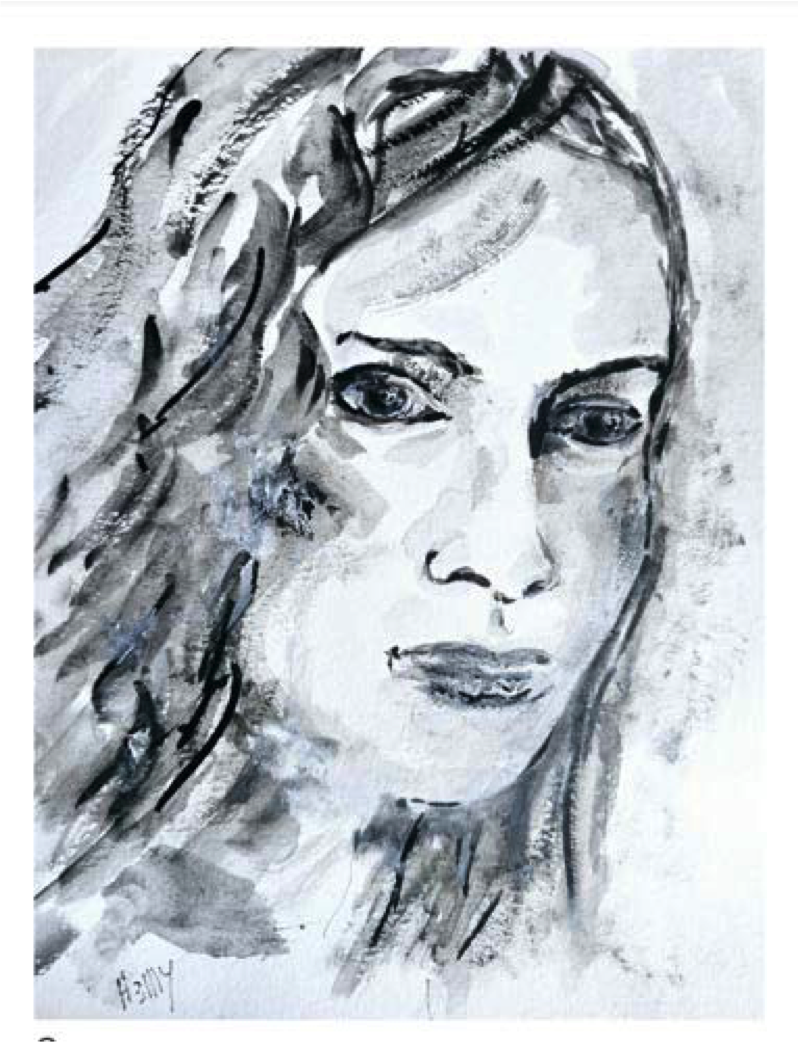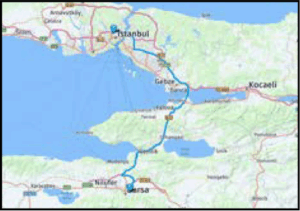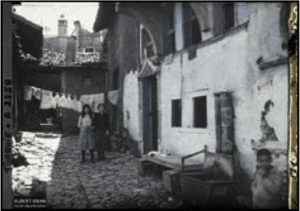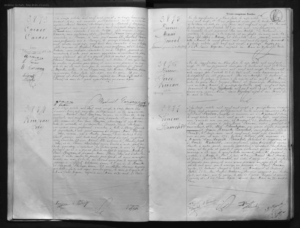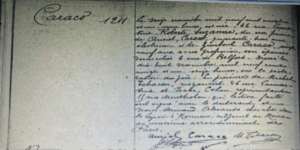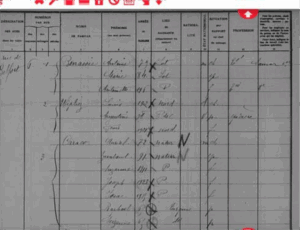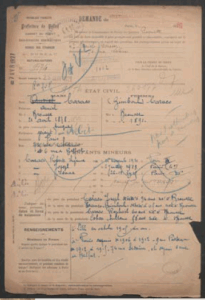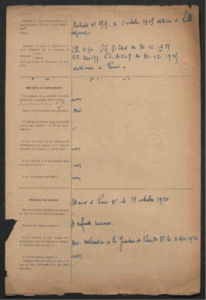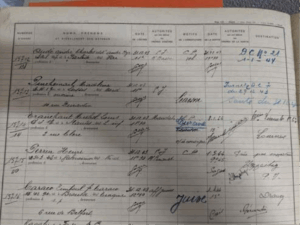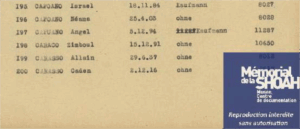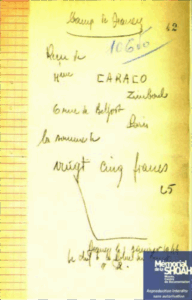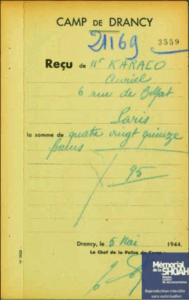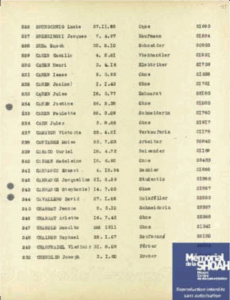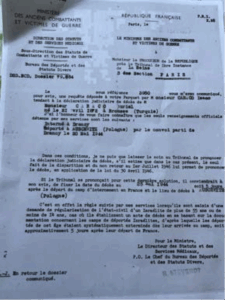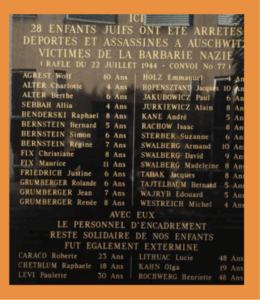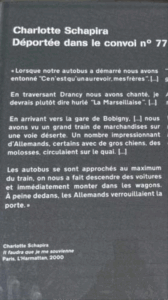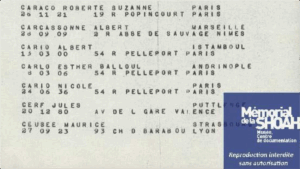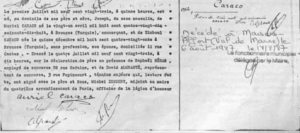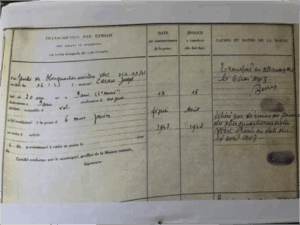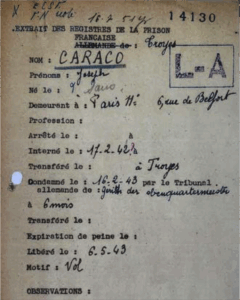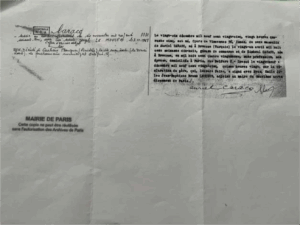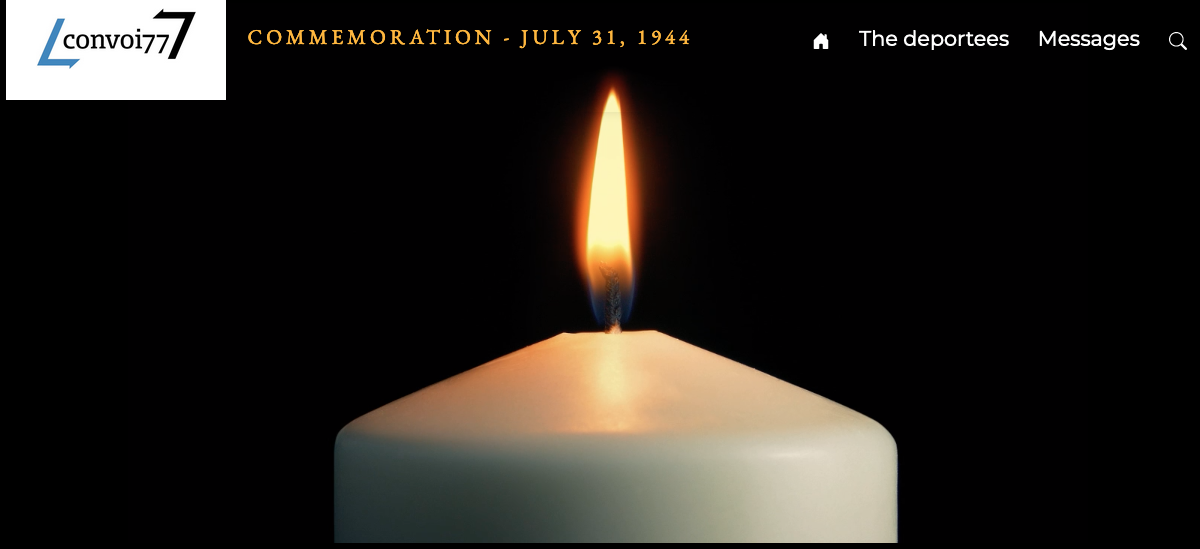Roberte CARACO
FOLLOWING IN THE FOOTSTEPS OF THE CARACO FAMILY
A pdf version of this biography, in French, can be found here
THE CARACO FAMILY’S TURKISH ROOTS
The Caraco family, who came from Turkey, was Jewish. We discovered that in the 16th century, many Sephardic Jews moved to the Ottoman Empire after having been forced out of Spain. The family lived in the town of Brousse, now called Bursa, which was on the Silk Road, and were in the silk-making business.
We know that several members of the family left Turkey early in the 20th century. However, we do not know whether or not Roberte Caraco’s parents, Auriel Caraco and Zimboul Caraco knew each other before they emigrated.
Nor do we know why they left. Might it have been for financial reasons? Or perhaps it was due to the political situation in Turkey? Nationalism was on the rise at the time, and this prompted many Jews to emigrate.
Image 1: Map showing the location of Brousse, now called Bursa, in Turkey
Image 2: The Jewish quarter in Brousse
AURIEL CARACO
Auriel’s parents were Joseph Caraco and Zimboul Franco. He was born on April 21, 1872 in Brousse, in Turkey.
He had two brothers and two sisters: Mazaltov, Raphaël, Elisabeth and Nissim.
ZIMBOUL CARACO
Zimboul was the daughter of Raphaël Caraco and Sultana Cohen. She was born on February 15, 189, also in Brousse. She had one brother, Marco and one sister, Rachel.
THEIR ARRIVAL IN FRANCE
The first record we have for the couple in France is Auriel Caraco’s naturalization request file, which he made in 1905 in Lille, in the Nord department of France, where he stayed for about a year. But how did he get to France? Did he travel alone, or with someone else, and if so, who? We do not know. He then moved the 11th district of Paris, which was home to a large Jewish community. He lived at 9 rue Pasteur from 1906 through 1912, then at 74 rue Sedaine from 1912 through 1915 and lastly at 6 rue de Belfort.
THEIR MARRIAGE
Zimboul Caraco and Auriel Caraco were married on October 12, 1920 in the town hall of the 11th district of Paris, where they were to stay for the rest of their lives.
A JEWISH FAMILY IN THE 11TH DISTICT OF PARIS
THEIR CHILDREN, ALL OF WHOM WERE BORN IN PARIS
- Roberte Suzanne was born on November 16, 1921 in the 9th district, at the home of her maternal aunt, Rachel Caraco, and her husband Michel Tchacon.
- Joseph was born on July, 1923, in the 4th district.
- Isaac was born on December 26, 1925 in the 12th district.
LIFE AT 6 RUE DE BELFORT
According to the 1926, 1931 and 1936 census records, the Caraco family lived at 6 rue de Belfort, where they had been since around 1919. We discovered from the 1936 census that Zimboul Caraco’s parents were living with them at the time. The children went to the local elementary schools, Roberte at 144 rue de la Roquette and the boys on rue des Boulets.
From Auriel’s naturalization file, we found out that his brother, Mazaltof, was still living in Turkey, while his other siblings were in France: Nissim and Raphaël in Paris, and Esther in Marseille. As for Zimboul Caraco’s family, they all lived in Paris. Her father died in 1936. Her mother, brother and sister all avoided being deported and killed in death camps.
THE FAMILY NATURALIZED AS FRENCH CITIZENS
Auriel Caraco applied for French nationality for himself and his family based on the years they had spent in France and the fact that the children were born in the country. A French law passed on August 10, 1927 had simplified the naturalization process in order to help immigrants integrate into French society. As a result, the minimum residence requirement was reduced to three years. Auriel Caraco was required to attend several hearings before being granted French citizenship. He also went before the Justice of the Peace in 1926 to have his children naturalized. Auriel and Zimboul Caraco were naturalized by decree on May 14, 1929.
THE PARENTS’ OCCUPATIONS
Auriel Caraco worked in a number of different jobs. We discovered that he was a traveling salesman, a street vendor, an employee and an electrician, for example. From 1914 to 1918, he was an electric lamp dealer at 97 boulevard Voltaire in Paris. In 1928, he declared that he ran a wine shop/restaurant and was earning 250 francs a week. The business was later sold. We also know that he had to go to Turkey that year, as he still had business interests there. He stopped working for good in 1940, and collected an “old workers’” pension of 6,000 francs. Zimboul Caraco was a stay-at-home mother.
Zimboul and Auriel Caraco’s marriage certificate
Roberte Suzanne Caraco’s birth certificate
1936 census listing
Pages from Auriel Caraco’s application for naturalization as a French citizen

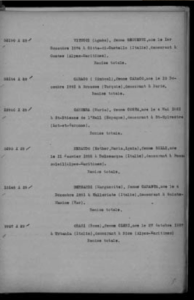
Auriel Caraco and Zimboul Caraco’s naturalization certificates, dated 1929
ZIMBOUL CARACO, THE FIRST TO BE DEPORTED
THE ARREST
Zimboul Caraco was arrested at the family home on December 31, 1943. The Germans then sealed off the apartment. The month before, in November the Vichy government had asked the prefects of all the departments in France to submit a list of all French Jews, who, up to that point, had not been too worried. During our visit to the Shoah Memorial in Paris, we looked at two other census returns, one from 1940 and the other from 1941. Both list Zimboul’s address and family situation as well as the fact that she was Jewish. The records come from what was called the “Jewish file”. After she was arrested, she was first taken to the local police station in the 11th district and from there to the Paris Police Headquarters before being transferred to Drancy internment camp, north of the city, where she arrived on January 1, 1944. From her internment card, we discovered that she was assigned the serial number 10650 and sent to a room on the 4th floor on staircase 9. The letter B on the card meant that she was liable to be deported immediately.
ARRIVAL IN AUSCHWITZ
Zimboul Caraco was deported to Auschwitz on Convoy 66 on January 20, 1944. During our field trip to Bobigny station, we learned that the prisoners often had to get up at 4 a.m. on the day they were to be deported. There was a roll call, and the prisoners were counted. Then, at 6 a.m., they were loaded onto buses and taken to the station, and at that time the convoys left from le Bourget station rather than Bobigny. Before they boarded, they were counted again. The trains often arrived the evening before, and were inspected by prisoners who were not going to be deported in order to avoid the risk of anyone escaping. Once they arrived, the deportees were told that if anyone escaped, they would be shot dead and their bodies put back in the car. Zimboul Caraco died on January 25, 1944. We understand from our research that due to her age, given that she was 52 years old at the time, she was most likely exterminated soon after she arrived in Auschwitz.
A record dated 1943 from the naturalization file
Zimboul Caraco’s detention record, before she was sent to Drancy
An extract from the Convoy 77 deportation list: it includes Zimboul Caraco’s name and her Drancy camp serial number
Zimboul Caraco’s receipt for the twenty-five francs that was confiscated from her when she arrived in Drancy
AURIEL CARACO, DEPORTED TO AUSCHWITZ
THE ARREST
We do not know why Auriel Caraco and the children, Roberte and Isaac were not arrested on December 31, 1943, nor what became of them after Zimboul was arrested. The naturalization file states that the authorities found no trace of him afterwards either, despite having carried out a search. It also says that the family remained French nationals during the war. Auriel Caraco was eventually arrested, but we do not know when or under what circumstances.
INTERNMENT IN DRANCY
Auriel Caraco arrived in Drancy on May 5, 1944. He was assigned the serial number 21169 and sent first to the 3rd floor on staircase 2, and then the 5th floor on staircase 19. His internment record, like that of Zimboul, includes a letter B, meaning that he could be deported immediately.
ARRIVAL IN AUSCHWITZ
Auriel Caraco was deported to Auschwitz on Convoy 74 on May 20, 1944. The journey took around 56 hours in total. Crammed into locked cattle cars, the deportees were rarely given any water. Depending on the season, they also suffered from anything from severe cold to stifling heat. Auriel Caraco died on May 25, 1944, very soon after he arrived, due to his advanced years. He was 72 years old.
Record of the decision confirming that the Caraco family should remain French citizens
Auriel Caraco’s search receipt, issued when he arrived in Drancy
An extract from the Convoy 77 deportation list: it includes Auriel Caraco’s name and his Drancy camp serial number
A record from Auriel Caraco’s deportation file. Among other things, it explains how the French authorities determined the date of death of people who never returned to France
ROBERTE CARACO, DEPORTED ON CONVOY 77
ROBERTE’S WORK AS A SUPERVISOR AT A UGIF CHILDREN’S HOME
We have a number of sources that state that Roberte Caraco was a supervisor at a children’s home run by the U.G.I.F. (Union Générale des Israélites de France, or General Union of French Jews). She still lived in the same neighborhood as her parents, but at 19 rue Popincourt. Before the Second World War, there was a train service from the Place de la Bastille to Varenne Saint-Hilaire, south west of Paris. It prompted the creation of orphanages along the Marne River, in which Jewish children were cared for in better circumstances than those in the capital. The Vichy government had set up the UGIF. at the behest of the Germans, and although the Nazis were ultimately in control of the children’s homes, they were run by Jews. The children, supervised by dedicated young people and adults who were also Jewish, were thus able to live in a safer environment, at least between 1942 and summer 1944. Some of the children were categorized as “free”, because their parents were not on the German or French authorities’ lists of Jews to be tracked down. The others whose parents were on such lists were referred to as “blocked” children, and although some of them went to school and were occasionally allowed to go into town, they were under the strictly monitored by the commandant of Drancy camp.
THE ROUNDUP AT VARENNE SAINT-HILAIRE
We know from her deportation file that Roberte Caraco was arrested during a roundup at the UGIF home in La Varenne Saint-Hilaire. On July 22, 1994, on the orders of SS commandant Aloïs Brunner, a group of Nazis and their collaborators arrested 28 children aged between 4 and 11 from the Zysman boarding house and the Beiss Yessoïmim orphanage at 30 rue Saint-Hilaire in La Varenne. The staff and supervisors, including Roberte Caraco, were also arrested. They were all taken to Drancy and then deported to Auschwitz, where they were all exterminated.
INTERNMENT IN DRANCY
Roberte Caraco was interned in Drancy from July 23 to 30, 1944. She was assigned the serial number 25,622 and sent to a room on the 4th floor on staircase 8. She was single and, like her parents before her, could be deported at any moment.
ARRIVAL AT AUSCHWITZ
Roberte Caraco was deported to Auschwitz on Convoy 77 on July 31, 1944. She was murdered soon after she arrived, on August “, and her official date of death was later declared to be August 5, 1944. Given that she was young and most likely fit enough to work, we suspect that she was killed immediately because she was unwilling to let go of the UGIF children she was travelling with. She was 22 years old.
“THE FEAR THAT CAME OVER US, THE PANIC THAT AROSE WITHIN US”
We found no trace of Roberte Caraco, neither written documentation nor photos of her or any of her family members. The sketch at the beginning of this biography was drawn by an artist known as H3llly, and reflects his own vision. Charlotte Schapira, who was deported on the same convoy, survived and returned to France. She wrote a book about her experiences and the children from the UGIF homes entitled “Il faudra que je me souvienne” (I must remember):
Model of Drancy internment camp
An extract from the Convoy 77 deportation list, including Roberte Caraco’s name, date of birth and address
JOSEPH CARACO, A HOLOCAUST SURVIVOR
CHILDHOOD
Joseph Caraco was born at home, 11 rue Castex in the 4th district of Paris, at 3 p.m. on July 1, 1923. He went to nearby elementary schools (such as the one at 129 rue des Boulets). A note in one of the school registers says that he was “undisciplined, with a poor attitude”. He passed the elementary school leaving certificate and then began industrial training at Trousseau.
LIFE DURING THE SECOND WORLD WAR
Joseph Caraco lived at home with his family. He did not join the army, but appears to have been a factory worker, although he was also described as a student. He also worked in the army mail or delivery service, where he was accused of stealing a package that he had hidden in his pants. He did not deny that he had the package, but said it was not for him and refused to name the other person. On February 16, 1943 a German court sentenced him to six months in jail. He was first sent to the Cherche-Midi prison in Paris and then transferred to another in Troyes, in the Aube department of France. There does not appear to have been any particular reason for this transfer other than the number of prison places. After three months there, he was granted a reprieve for good behavior, but only on condition that he agreed to go to work in Germany for a year. He was released from Troyes prison on May 6, 1943. His medical records suggest that he arrived in Germany on May 16, 1943, but we have no information as to when or how he returned to France.
AFTER THE WAR
Joseph Caraco married a woman called Odette Gendro. We learned from a genealogy website that after his wife’s death, he placed their daughter with her maternal grandmother. He appears to have lived on the edge of mainstream society. He died on July 6, 1987 in Maisons-Alfort in the Val-de-Marne department of France.
Joseph Caraco’s birth certificate
Proof of Joseph Caraco’s return to France. It states that he was “requisitioned” (meaning that he was in the STO, a compulsory work service scheme)
Troyes prison records for Joseph Caraco
ISAAC CARACO, A HOLOCAUST SURVIVOR
LIFE BEFORE 1945
Isaac Caraco was born in a maternity home in the 12th district of Paris on December 26, 1925. He went to the local elementary school, like his older brother, and he too lived at home with the family. He worked as an electrician in the Amilcar automobile factory in Boulogne-Billancourt, in the western suburbs of Paris, where he earned 7.50 francs. We do not know why he was not arrested at the same time as his mother on December 31, 1943, nor why he was not arrested later in the war. Neither do we who, if anyone, he lived with, nor where he lived during that time.
ISAAC’S ATTEMPT TO FIND OUT WHAT HAD BECOME OF HIS FAMILY
Having survived the war, Isaac Caraco set about trying to find out what had happened to his parents and his sister, Roberte, as he had heard nothing of them since the war ended. We found a record of this in his sister’s deportation file. He also actively lobbied for to have his family granted “political deportee” status, and for the words “Died for France” to be added to their death certificates.
THE POST-WAR YEARS
In 1954, Isaac Caraco was living at 28 rue Lepeu Projetée in the 12th district of Paris. He married Léa Marie Joseph Le Moulec on November 6, 1963 in the same district. The couple had a son, Christian, who later had a daughter of his own, called Delphine. Isaac retired to Brittany, where he died on May 12, 2002 in Carhaix-Plouguer, in the Finistère department. We contacted his granddaughter via the social networks, but she was unable to shed any light on her family history.
A statement that Isaac Caraco wrote in relation to the disappearance of his sister, Roberte
Isaac Caraco’s birth certificate, issued by the town hall of the 12th district of Paris)
SOURCES
- French National archives for Paris (birth and marriage certificates, census data,
school registers etc.…) - French National archives in Pierrefitte: Naturalization file n° 52164 X 28
for Auriel Caraco and Zimboul Caraco, ref. cote BB/11/10758 - French National archives in Pierrefitte: Naturalization file n° 3714 X 26 for the
Caraco children, ref. cote BB/11/9213 - French Historical Defense Service archives in Caen: Dossiers on Auriel Caraco (AC 21 P 433200 and AC 21 P 249049), Zimboul Caraco (AC 21 P 433208 and AC 21 P 249050) and Roberte Suzanne Caraco (AC 21 P 433204 and AC 21 P 249051)
- Shoah Memorial, Paris
- Paris Police headquarters: arrest record for Zimboul Caraco (CC2 Prison register for temporary detainees at the depot (1941-1970)
- Aube departmental archives (Prison record for Joseph Caraco, detained in the à la Hauts-Clos prison in Troyes.)


 Français
Français Polski
Polski